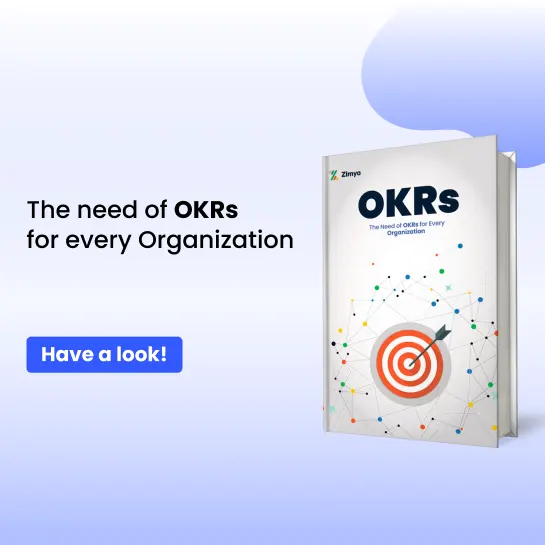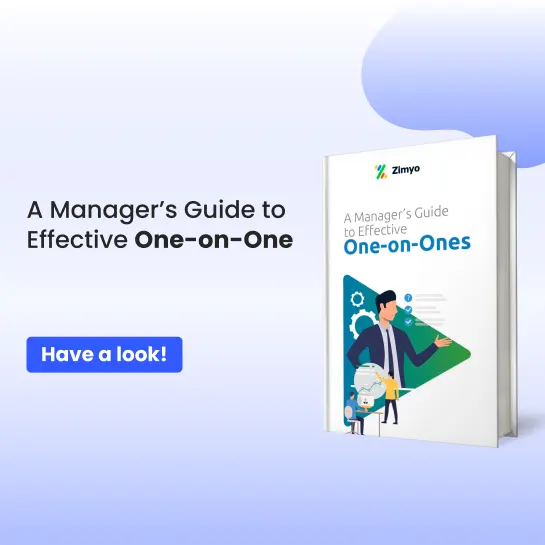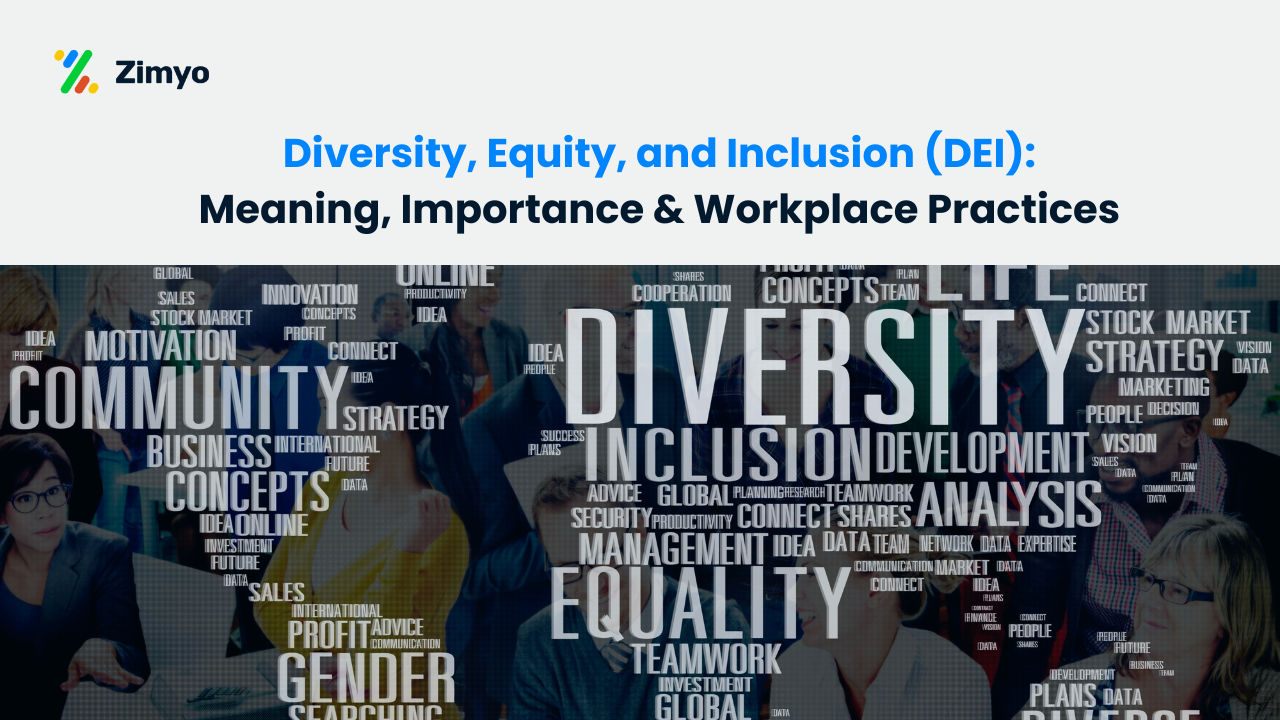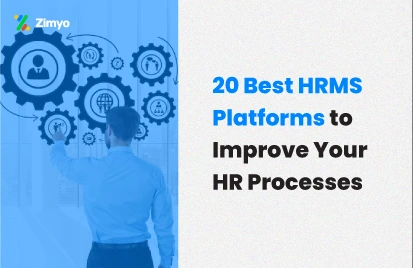Every successful organization is built on the strength of its people. Where employees are considered as the driving force behind innovation, growth, and business outcomes. It’s important to understand that as businesses grow, as do the challenges of managing their employees. From tracking attendance, processing payroll, onboarding new hires, and ensuring timely compliance – can quickly become overwhelming.
This is where HRMS software is used. Abbreviated as Human Resource Management System. An HRMS assists businesses in handling everything about their employees within a single central location. Rather than handling multiple spreadsheets, emails, and different applications. Organizations can make use of an HRMS system to organize, automate, and enhance their HR processes.
In this detailed guide, we’ll explore what HRMS software is, its history, why it matters for modern businesses, its core features, benefits, and why companies prefer solutions like Zimyo HRMS.
In India, adoption of HRMS and payroll automation has grown significantly post-pandemic, with SMBs leading the way.
What Is HRMS Software?
It could be understood as – HRMS software is a digital platform that integrates all HR functions into a single, easy-to-use system. Included HR functions range from hiring and onboarding to payroll, performance reviews, and employee engagement.
You can think of it as having one solution that tracks employee information, processes payrolls, handles leave applications, tracks attendance, and even assists in talent management. Overall, it acts as a smart assistant to HR teams, managers, and employees.
Some of the core operations of an HRMS system include:
- Automating payroll and compliance.
- Organizing employee information in a central repository.
- Streamlining recruitment, onboarding, and offboarding processes.
- Providing employee self-service portals.
- Assisting managers in monitoring performance and allocating goals.
- Sharing information with workforce reports and analytics.
HRMS management basically takes the mess out of HR operations and puts in place order, efficiency, and clarity.
History of Human Resource Management Systems
The evolution of HRMS software is deeply intertwined with the development of the workplace themselves.
Manual Era (Pre-1970s): HR functions were totally paper-intensive. Employee records were maintained in files, payroll calculations were manual and tedious, and prone to errors.
Introduction of Computers (1970s–1980s): Companies started using simple digital systems for payroll and record-keeping. These were freestanding devices, not part of an integrated system.
Emergence of Enterprise HRMS (1990s): Enterprises such as SAP and Oracle brought enterprise HRMS, integrating payroll, workforce management, and reporting into a single system.
Cloud-Based HRMS (2000s onwards): With cloud technology, HRMS reached small, medium, and large businesses. Cloud-based HRMS brought in self-service portals, automation, and real-time analytics.
HRMS Modern (Today): Now let’s talk about the current HRMS software – today these systems employ AI, mobile applications, and predictive analysis. They manage workers, allow organizations to attract, retain, and develop talents strategically.
This has come a long way to illustrate that human resource management systems have expanded from administrative tools to becoming fundamental business drivers.
Why Is HRMS Software Important for Businesses?
In the modern business landscape, efficiency is paramount. Manual HR processes hold businesses back and expose them to potential errors. HRMS software comes to the rescue by automating operations, delivering transparency, and enhancing employee experience.
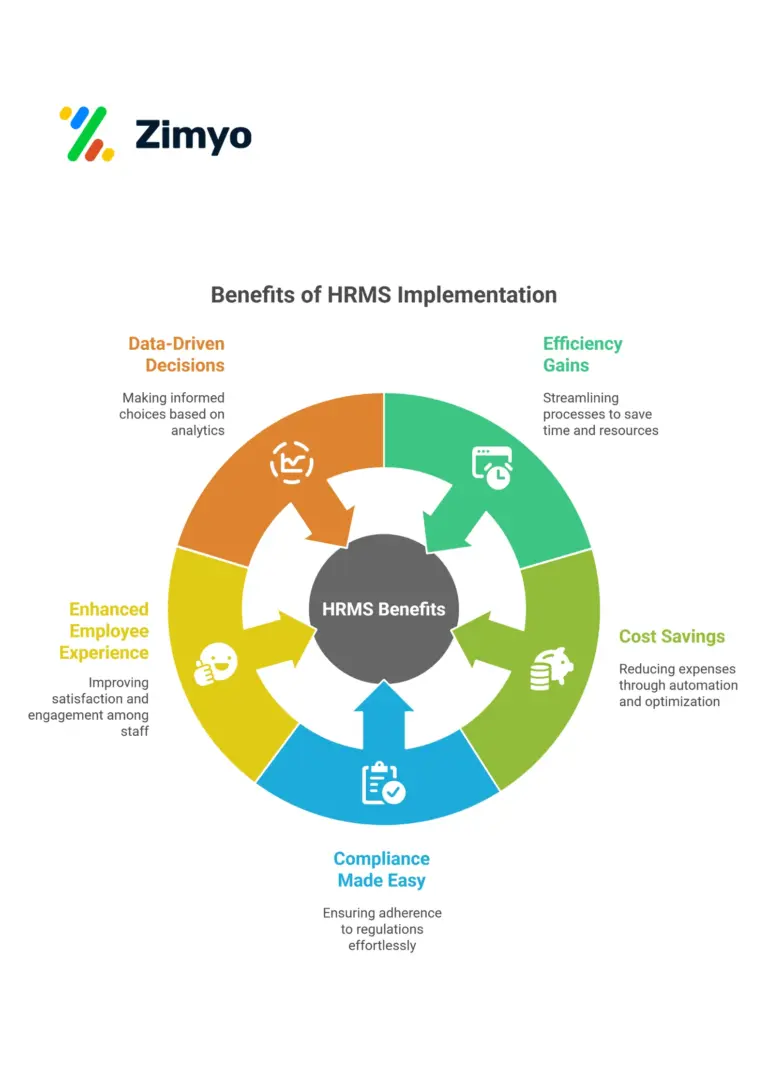
Here’s why it counts:
- Efficiency Gains – Automates repetitive HR tasks such as payroll, leave approval, and attendance tracking.
- Cost Savings – Eliminates the necessity of big HR teams and cuts down on expensive mistakes.
- Compliance Made Easy – Stays ahead of tax regulations, labor law, and compliance with statutes without additional effort.
- Enhanced Employee Experience – Empowers workers with access to their payslips, leave totals, and HR services at their fingertips.
- Data-Driven Decisions – Offers insights into workforce trends, turnover rates, and performance metrics.
For companies with growth ambitions, having an HRMS system is not merely a choice—it’s a requirement.
The global HR software market is expected to reach $33 billion by 2031, growing at a CAGR of over 10% (source: Allied Market Research).
Who Uses HRMS Software?
Traditionally speaking, HR functions like recruitment, payroll, performance management, and employee engagement used to operate in isolation, so that information from one didn’t really flow into another. Contemporary HRMS systems eliminate this isolation by centralizing data, curtailing communication, and making sure that insights accumulated in one area help the entire organization.
Here’s how various groups stand to benefit from the use of HRMS software:
HR Teams: Beyond being a repository of data for human resources professionals, an HRMS can assist them in keeping employee records in check, producing sophisticated reports, and automating functions such as payroll, compliance, and talent management. This leaves them with more precious time to spend on strategic HR activities like employee engagement and culture-building.
Recruiters: Recruitment becomes simpler with HRMS software that brings a single platform for job promotions, candidate tracking, resume management, and digital onboarding. Recruiters are able to build talent pipelines, monitor applications in real time, and build a seamless experience for new hires.
Managers: Managers are able to monitor team performance, approve leave, monitor attendance, and track employee goals from any location at any time using mobile-friendly HRMS solutions. The system assists them in offering timely support and feedback, keeping their teams motivated and productive.
Employees: An employee self-service portal allows employees to manage their own HR requirements. They can modify personal details, request leaves, access payslips, view training calendars, and even monitor career development—all without relying on HR.
Job Applicants: Contemporary HRMS system tend to carry job applicants’ features as well, providing them with their own portals in which they are able to search available job positions, apply for jobs, track their application status, and even electronically sign offers.
I was able to implement the platform on my own. It helps in assigning the tasks to other employees, conducting surveys and polls, and much more. The ease of use and self-onboarding is something that I would like to appreciate.
Sonali, Kommunicate
Zimyo simplifies attendance management for our organization. The leave and attendance are so streamlined that we have never faced any difficulties with the system.
Anurag, Eggoz Nutrition
HRMS Software Components & Capabilities
An HRMS system is not a single tool—it’s an entire ecosystem of modules that are meant to encapsulate the entire employee lifecycle. Every part has a crucial role to play in making HR processes seamless and efficient. Let’s dissect them:
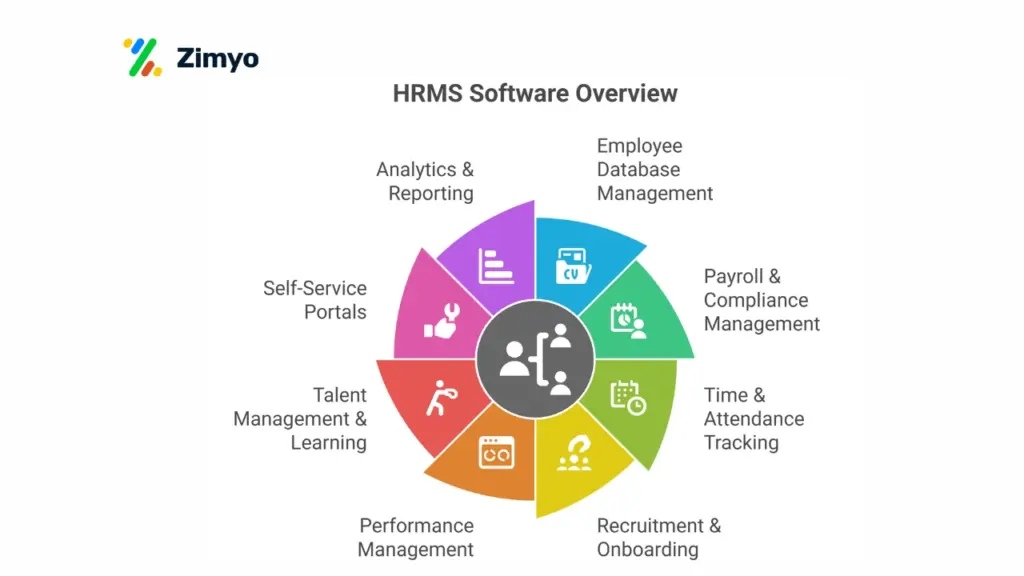
1. Employee Database Management
Each organization requires a single location for all employee data. HRMS software produces a safe, digital file cabinet for employee records like personal information, employment history, abilities, compensation, and performance. No more messy spreadsheets – all organized, searchable, and available in seconds.
2. Payroll & Compliance Management
Payroll is amongst the most intricate and error-sensitive functions for HR departments. An HRMS calculates salaries, deduct taxes, reimburse employees, and ensures compliance with labor legislation on auto mode. This helps employees get paid correctly and within time, while companies remain up to date with labor legislation.
3. Time & Attendance Tracking
With integrated biometric systems, mobile check-ins, and automated attendance records, HRMS saves the inconvenience of manual tracking. Managers can see shift schedules, absenteeism trends, and overtime information in real-time.
4. Recruitment & Onboarding
It is essential to hire the right individuals rapidly for growth. HRMS software enables recruiters to cross-post jobs, screen candidates, and perform smooth onboarding. New employees can fill out electronic paperwork, view company policies, and get up to speed quicker.
5. Performance Management
Contemporary HRMS solutions are more than yearly appraisals. They provide ongoing performance monitoring, goal and performance management, peer review, and performance appraisal. This allows managers to guide employees more effectively and connect personal goals with organizational ones.
6. Talent Management & Learning
Growth-oriented companies recognize that it is equally essential to hold on to employees and grow them as hiring them. HRMS solutions facilitate training, career plans, skill gap analysis, and succession planning.
7. Self-Service Portals
Employees do not need to run around HR for standard requests anymore. A self-service portal enables them to download payslips, request leaves, change personal information, and view training resources at their leisure.
8. Analytics & Reporting
HRMS software transforms data into actionable insights. Turnover trends, hiring success rates, real-time reports, and dashboards enable business leaders to make fact-based, informed decisions.
Many HR teams spend up to 70% of their time on admin tasks rather than strategic initiatives - HRMS reduces this drastically.
Why Use an HRMS System?
In a world where corporations are going more digital, the HR processes can’t lag behind. Here’s why getting an HRMS system is a sensible decision:
- Decreases Administrative Overload: Automating routine processes makes HR professionals free to concentrate on strategic tasks rather than paperwork.
- Increases Compliance: Labor laws and tax laws keep changing. HRMS ensures payroll and statutory processes remain compliant at all times.
- Empowers Hybrid Work Models: Mobile access and cloud-based functionalities enable managers and employees to stay in touch irrespective of geographical locations.
- Increases Employee Satisfaction: An open system where the staff can monitor their requests, objectives, and payroll enhances faith and motivation.
- Empowers Decision-Making: Advanced analytics enable insights into workforce projections, high performers, and attrition reduction.
Simply put, HRMS is more than an operational tool, it’s a strategic facilitator for business growth.
I was able to implement the platform on my own. It helps in assigning the tasks to other employees, conducting surveys and polls, and much more. The ease of use and self-onboarding is something that I would like to appreciate.
Sonali, Kommunicate
Zimyo simplifies attendance management for our organization. The leave and attendance are so streamlined that we have never faced any difficulties with the system.
Anurag, Eggoz Nutrition
HRMS Software Advantages
Implementing HRMS software has numerous benefits to employers and workers alike:
- Accuracy in Payroll – Eradicates human errors in calculations, distributing correct and timely salaries.
- Time Savings – Saves time on mundane tasks, allowing HR teams to focus on employee engagement and growth strategies.
- Employee Empowerment – Self-service access empowers employees to take control of their HR requirements.
- Data Security – Secures sensitive employee data with encryption and role-based security.
- Scalability – Seamlessly grows with your expanding workforce, from 50 to 5,000 employees.
- Cost Efficiency – Reduces administrative burdens, resulting in long-term cost savings.
- Better Compliance – Integrated compliance ensures organizations remain compliant with labor legislation and tax authorities.
HRMS, when properly implemented, becomes a foundation for productivity, employee happiness, and business growth.
Choosing an HRMS System – Steps
Selecting the appropriate HRMS system for your company may become daunting with such a wide variety available in the market. The following is a systematic way to guide you through the process of making the right choice:
- Determine Your Business Needs: Begin by writing down your HR pain points. Is payroll your top headache? Or do you require improved recruitment capabilities?
- Prioritize Features: Draw up a must-have vs. nice-to-have list. Typical necessities are payroll, compliance, attendance, and performance monitoring.
- Test User Experience: An overly complex HRMS will infuriate employees. Select one that is simple and intuitive to use.
- Assess Vendor Reputation: Opt for vendors with good customer reviews, good support, and successful implementation history.
- Think about Scalability: Make sure the HRMS scales with your company’s needs.
- Compare Prices: Don’t compare prices only—compare long-term value, upgrades, and support.
- Request a Demo: Always try out the system before deciding to ensure it integrates well with your workflow.
The correct HRMS should adapt to your business and not the business to it.
Reasons Why Businesses Choose Zimyo HRMS
The HR tech space is filled with solutions, yet not all of them are created for the conditions of today’s businesses. Most platforms either are inflexible, too difficult to use, or have a high cost associated with them. Zimyo HR Software stands out from the pack—it provides robust HR and payroll software that is easy, affordable, and centered on employee experience.
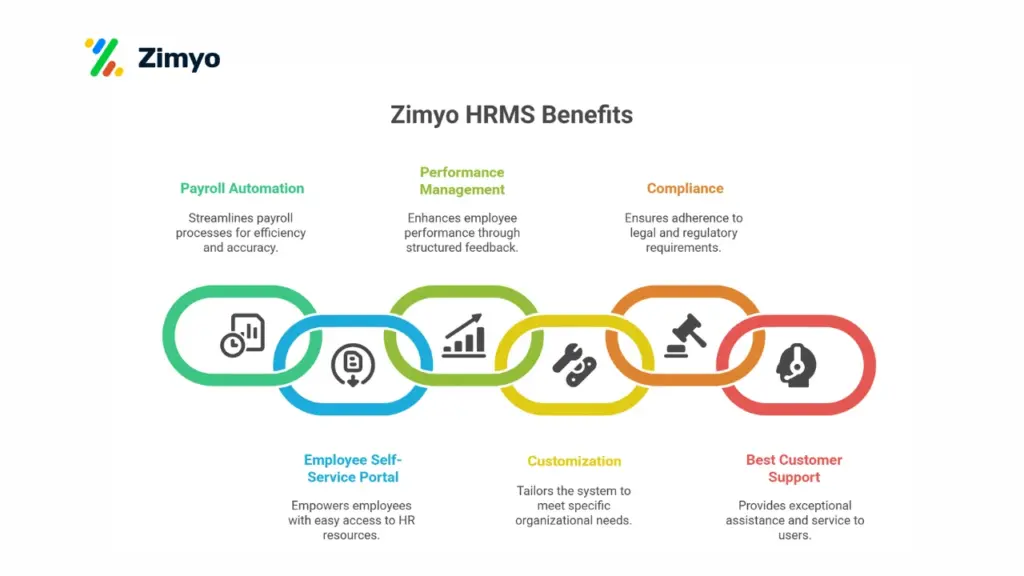
Following are some strong reasons why organizations ranging from startups to enterprises prefer Zimyo HRMS over others:
1. An All-in-One HRMS System
Rather than handling various tools, Zimyo consolidates all of them under one platform. From attendance management and leave management to automated payroll and talent management, companies receive a full-fledged human resource management system within one platform. This is time-saving, error-free, and makes HR operations easier.
2. Smooth Payroll Automation
Payroll mistakes can infuriate employees and break trust. With Zimyo HR and payroll software, organizations can automate salary payment, handle reimbursements, process deductions, and comply with Indian statutory regulations such as PF, ESI, and TDS. The outcome? Timely, accurate salaries without the hassle.
3. Improved Employee Experience
Zimyo puts employee empowerment at its core. Through self-service portals and mobile-enabled access, employees can see payslips, request leaves, track attendance, and even define individual career objectives, all independent of HR. Transparency fosters trust and increases engagement.
4. Talent Management Simplified
Keeping talent on board is as critical as acquiring them. Zimyo’s HRMS has features such as performance monitoring, goal alignment, feedback loops, and learning modules through which organizations can develop and retain talent. This simplifies the creation of a growth-driven work culture.
I was able to implement the platform on my own. It helps in assigning the tasks to other employees, conducting surveys and polls, and much more. The ease of use and self-onboarding is something that I would like to appreciate.
Sonali, Kommunicate
Zimyo simplifies attendance management for our organization. The leave and attendance are so streamlined that we have never faced any difficulties with the system.
Anurag, Eggoz Nutrition
5. Customizable & Scalable
Each company is one of a kind, and Zimyo gets it. Its HRMS modules can be customized to suit various industries; be it IT and manufacturing or retail and services. And the system easily grows with businesses, making it an investment for the future.
6. User-Friendly Design
In contrast to most HRMS solutions that burden users with complicated interfaces, Zimyo is user-friendly. HR teams, managers, and employees love using it as it is simple and intuitive, thereby leading to faster adoption and greater satisfaction.
7. Data Security & Compliance
Managing employee information is a delicate operation. Zimyo HRMS is developed with enterprise-level security to protect sensitive data. It also helps companies remain compliant with evolving labor laws, minimizing the chances of paying penalties.
8. Reasonable Pricing with High Value
Most HRMS companies have very high subscription costs that small and medium enterprises cannot afford. Zimyo provides affordable plans without diluting features, so organizations of any size can afford it.
9. Dedicated Support & Smooth Implementation
Embracing new technology is intimidating, but Zimyo makes it seamless. With customer support and training, companies receive hands-on guidance while implementing and after, guaranteeing the utmost value from the platform.
Conclusion
The HR function has evolved from being an administrative task to a strategic force that fuel employee inspiration and business success. To adapt to this change, companies require tools that are efficient, scalable, and employee-centric.
HRMS software fills the gap between, by automating HR activities, ensuring conformity, and implementing a smooth experience for employers and employees alike. From payroll to performance management, recruitment to retention, HRMS does it all.
And as far as selecting the right platform is concerned, Zimyo HRMS is the best, reliable, feature-rich, and affordable option. Using it, organizations not only reduce costs and save time but also create a better, more transparent workplace.
In this competitive age, an HRMS isn’t mere software; it’s the starting point for a better, more future-proofed organization.
FAQs
What software is HRMS?
HRMS (Human Resource Management System) is software that manages HR tasks like payroll, attendance, and performance. Tools like Zimyo HRMS make these processes easier and more efficient.
Which is the best HRMS software in India?
Zimyo HRMS is one of the best in India, offering payroll, compliance, and employee management in a simple, affordable platform.
Which software is best for HR?
The best HR software is one that automates tasks and improves employee experience. Zimyo HR and payroll software is a top choice for businesses of all sizes.
What are the 7 functions of HRM?
The 7 core functions of Human Resource Management (HRM) include:
- Recruitment & Staffing
- Employee Onboarding
- Training & Development
- Performance Management
- Compensation & Payroll
- Employee Engagement & Relations
- Compliance & Record-Keeping

